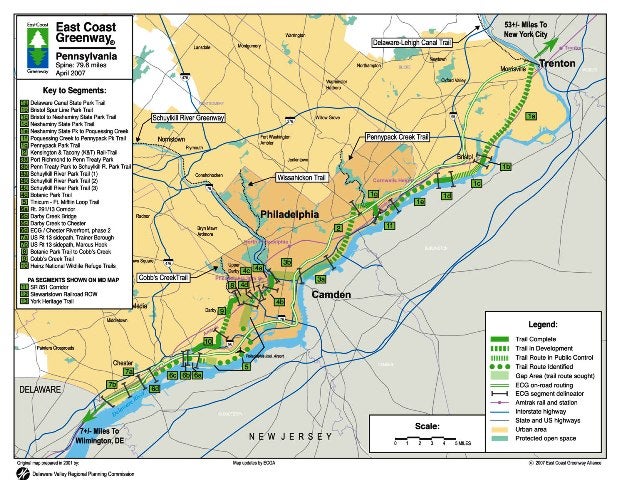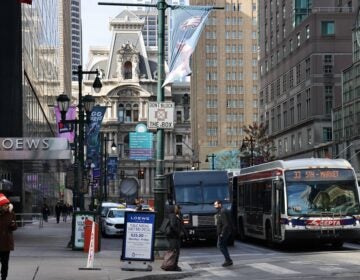Bridging our rivers with a green link

Oct. 29
By Kellie Patrick Gates
For PlanPhilly
Bikers, hikers, walkers and roller-bladers may one day cross Philadelphia, from the Delaware River to the Schuylkill River, without facing a single car.
The Pennsylvania Environmental Council has begun planning a multi-use trail that would link existing and planned trails along the two rivers, joining Philadelphia to the East Coast Greenway – a series of connections that eventually will run from Maine to Florida.
Spencer Finch, the Pennsylvania Environmental Council’s director of sustainable development, said the trail would not just be for long-haul hikers and bikers. It would be a safe way for anyone to get from one side of the city to another – or travel to points between.
One goal is to help rev up commercial corridors – so the trail would have easy on-and-off points near restaurants and shops. The trail would also likely link a series of green spaces, so people could stop and rest in a tranquil spot.
“It might even become a commuting option – people could take it from home to work instead of driving or taking a bus,” he said. “Everybody will be using this. You don’t have to be a speed freak or the bike messenger that likes to bash through traffic to use this.”
This week, the PEC will chose a consultant who will narrow a list of 12 possible locations for the cross-town trail to somewhere between two and four, Finch said. Eventually, the goal is to build more than one, he said.
The choices range from as far north as Port Richmond, where the PEC could use an abandoned railroad line near the New Frankford Creek to as far south as Pattison Avenue near the stadiums.
But the bulk of the options are in or near Center City.
Finch said he expects the list to be narrowed down by June. The results would be discussed with the East Coast Greenway organizers before construction begins. It will take at least two years after that to complete the first cross-town trail, he said.
Joe Syrnick, President of the Schuylkill River Development Corporation, loves the idea of connecting the two rivers’ trails. The connection would “raise the status and stature (of the Schuylkill River Trail), raise the number of people using the trail, and maybe in the long run, help get funding for the trail – basically all good stuff,” he said.
Syrnick hopes hard that at least one of the connecting trails will traverse the city north of Boathouse Row.
The Greenway and all its component trails aim to give users an interesting mix of things to look at, Syrnick says. And if the connecting trail is too far south, users would miss “boathouse row, which is interesting and scenic; the waterworks, which is a historic landmark, and the Art Museum, which is perhaps the most majestic building in Philadelphia.”
In other words, he said, what’s a scenic trail through Philadelphia without some of the city’s best scenes?
The section of the Schuylkill River Trail from Boathouse Row to Grays Ferry Avenue has already been designated as part of the East Coast Greenway – it was the first named section of the greenway in the state – so it would not make sense to have the connection bypass it, he said.
Whatever locations are chosen for the connecting trails, most would wind up being narrow, linear parks, with lots of green space and no cars.
“We don’t want just to put some pavement down and put some paint on it,” Finch said. “We want a high-quality greenway with landscaping and buffers.”
One proposal calls for using the abandoned Reading Viaduct – formerly the route of commuter rail lines. The huge stone embankment can be seen on one side of Vine Street between 10th and 11th.
“It winds its way through the Loft District and Northern Liberties,” Finch said. “We could put a park and a greenway right up there, on top of it, and have an expressway for bicycles.”
Zoning Board of Adjustment Chairman David Auspitz said it sounds great to him. He loves to ride his bike, but not where he has to deal with traffic.
There is one unusual proposal – a Girard Avenue connection. Instead of riding a bike across the city, riders would either take their bikes on the trolley with them or park their bikes at a bike station – a sort of garage for bicycles, which would have a guard and possibly lockers and showers.
The PEC doesn’t have a bike station project now, but is talking with several organizations in the city about such a possibility for Philadelphia, Finch said.
He would like to see bike stations regardless of where the connection happens. The showers and lockers would make it much easier for people to use the trail to commute to work, he said.
Regardless of the site or sites chosen for the multipurpose trail, it is likely that a smaller, walking trail will also be created – and this one would meander through small, Philadelphia streets to give walkers a sense of the city, Finch said.
The feasibility study will cost around $100,000 and will be paid for by a grant from the Pennsylvania Department of Conservation and Natural Resources, as well as portions of grants from the Department of Environmental Protection and the William Penn Foundation.
Kellie Patrick Gates is a former Philadelphia Inquirer reporter. Contact her at kelliespatrick@gmail.com
WHYY is your source for fact-based, in-depth journalism and information. As a nonprofit organization, we rely on financial support from readers like you. Please give today.






